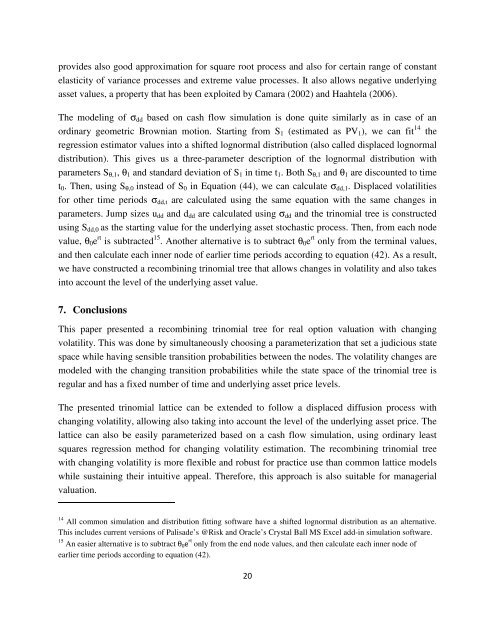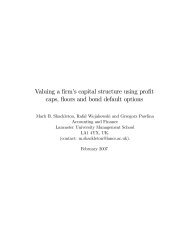Recombining Trinomial Tree for Real Option Valuation with ...
Recombining Trinomial Tree for Real Option Valuation with ...
Recombining Trinomial Tree for Real Option Valuation with ...
- No tags were found...
Create successful ePaper yourself
Turn your PDF publications into a flip-book with our unique Google optimized e-Paper software.
provides also good approximation <strong>for</strong> square root process and also <strong>for</strong> certain range of constantelasticity of variance processes and extreme value processes. It also allows negative underlyingasset values, a property that has been exploited by Camara (2002) and Haahtela (2006).The modeling of σ dd based on cash flow simulation is done quite similarly as in case of anordinary geometric Brownian motion. Starting from S 1 (estimated as PV 1 ), we can fit 14 theregression estimator values into a shifted lognormal distribution (also called displaced lognormaldistribution). This gives us a three-parameter description of the lognormal distribution <strong>with</strong>parameters S θ,1 , θ 1 and standard deviation of S 1 in time t 1 . Both S θ,1 and θ 1 are discounted to timet 0 . Then, using S θ,0 instead of S 0 in Equation (44), we can calculate σ dd,1 . Displaced volatilities<strong>for</strong> other time periods σ dd,t are calculated using the same equation <strong>with</strong> the same changes inparameters. Jump sizes u dd and d dd are calculated using σ dd and the trinomial tree is constructedusing S dd,0 as the starting value <strong>for</strong> the underlying asset stochastic process. Then, from each nodevalue, θ 0 e rt is subtracted 15 . Another alternative is to subtract θ 0 e rt only from the terminal values,and then calculate each inner node of earlier time periods according to equation (42). As a result,we have constructed a recombining trinomial tree that allows changes in volatility and also takesinto account the level of the underlying asset value.7. ConclusionsThis paper presented a recombining trinomial tree <strong>for</strong> real option valuation <strong>with</strong> changingvolatility. This was done by simultaneously choosing a parameterization that set a judicious statespace while having sensible transition probabilities between the nodes. The volatility changes aremodeled <strong>with</strong> the changing transition probabilities while the state space of the trinomial tree isregular and has a fixed number of time and underlying asset price levels.The presented trinomial lattice can be extended to follow a displaced diffusion process <strong>with</strong>changing volatility, allowing also taking into account the level of the underlying asset price. Thelattice can also be easily parameterized based on a cash flow simulation, using ordinary leastsquares regression method <strong>for</strong> changing volatility estimation. The recombining trinomial tree<strong>with</strong> changing volatility is more flexible and robust <strong>for</strong> practice use than common lattice modelswhile sustaining their intuitive appeal. There<strong>for</strong>e, this approach is also suitable <strong>for</strong> managerialvaluation.14 All common simulation and distribution fitting software have a shifted lognormal distribution as an alternative.This includes current versions of Palisade’s @Risk and Oracle’s Crystal Ball MS Excel add-in simulation software.15 An easier alternative is to subtract θ 0 e rt only from the end node values, and then calculate each inner node ofearlier time periods according to equation (42).20



